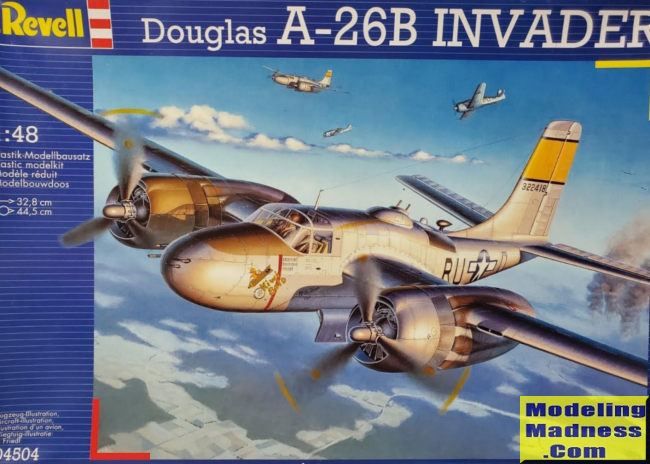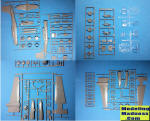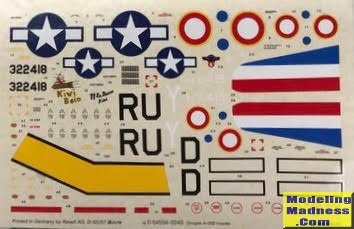
Revell 1/48 A-26B Invader
| KIT #: | 04504 |
| PRICE: | Around €35 in 2003 |
| DECALS: | Two options |
| REVIEWER: | Spiros Pendedekas |
| NOTES: | Monogram tooling |

| HISTORY |
The A-26 Invader is an American twin-engined light
bomber and ground attack aircraft. Built by Douglas Aircraft Company during
World War II, it also saw service during several major Cold War conflicts, with
a limited number of highly modified USAF aircraft serving in Southeast Asia
until 1969. It was a fast aircraft capable of carrying a large bomb load, while
a range of guns could be fitted to produce a formidable ground-attack platform.
A redesignation of the type from A-26 to B-26 between 1948 and 1965 led to
confusion with the Martin B-26 Marauder, which, though sharing the same engine,
was a completely different and separate design. A total of 2,503 Invaders were
built.
| THE KIT |
 Monogram
came in 1993 with its new tool quarter scale Invader. Two years later it was
issued as the Pro Modeler version, with some extra sprues (containing extra
parts, not only to build different versions - glazed nose, the later bulged
canopy, underside turret, rockets - but also weighted tires extra wheel bays
walls, crew members and chocks) and, of course, featuring wonderful Pro Modeler
style instructions with reference pics. Revell has reboxed this Pro Modeler kit
another three times (the last one in 2017), whereas Monogram and Hasegawa have
seemingly reboxed the original tooling (without the extra sprues).
Monogram
came in 1993 with its new tool quarter scale Invader. Two years later it was
issued as the Pro Modeler version, with some extra sprues (containing extra
parts, not only to build different versions - glazed nose, the later bulged
canopy, underside turret, rockets - but also weighted tires extra wheel bays
walls, crew members and chocks) and, of course, featuring wonderful Pro Modeler
style instructions with reference pics. Revell has reboxed this Pro Modeler kit
another three times (the last one in 2017), whereas Monogram and Hasegawa have
seemingly reboxed the original tooling (without the extra sprues).
The specific kit is the 1996 Revel edition, bought from one of my then usual
(now, sadly, closed) toy/hobby shops in my town, Chalkis, carrying a fair price
tag. It comes in the typical big blue Revell top opening box, carrying a very
nice box art of 554 BS “RU-D” bird, as it stood in June 1945 at Sint-Truiden,
Belgium.
Upon opening the box, I was greeted with 153 medium gray styrene parts arranged
in four large and four small sprues, eight sprues in total. Molding is good with
little flash, as expected from the only three years old molds by the time of the
kit’s issue. Being one of the latest Monogram molds of the raised panel lines
era, means that this kit’s panel lines are well done, depicting to a good degree
the actual surface detailing.
Whereas overall dimensions seem for the most part correct, the fuselage cross
section is wider than it should be, something that became clearly evident upon
comparison with the 2019 ICM release, which features a correctly shaped
fuselage.
Crew interior is adequately rendered, featuring a good amount of details at all
visible places, including the side walls and bulkheads and the same can be said
for the bomb bay. The interior out of the box will be satisfactory for a good
number of us, whereas one can easily go superdetailing it. The other key areas
(landing gear and engines) are also well done, as are the props. Two styles of
tires are provided, weighted and unweighted. The distinctively angled horizontal
stabilizer is impressively molded as a single piece, whereas the rest of the
parts (guns, bombs, rockets, various antennas and so on) are sufficiently
represented.
Transparencies are well molded and crystal clear. Instructions are very well
done per the typical Revell A4 b/w booklet style, containing a short history of
the type, a pic of a completed model, a sprue map, with the construction spread
in 24 concise and uncomplicated steps, with color callouts where applicable.
 Two schemes
are provided, for a 554 BS “RU-D” USAAF bird, as it stood in Belgian
Sint-Truiden by June 945 in natural metal finish (NMF), and for Armée de l'Air
GB 2/91 plane, as it stood in Bone, Algeria, by June 1960, in black, with a part
of the fuselage top in aluminum. Decals are very nicely printed and still look
usable, despite being almost 30 years old.
Two schemes
are provided, for a 554 BS “RU-D” USAAF bird, as it stood in Belgian
Sint-Truiden by June 945 in natural metal finish (NMF), and for Armée de l'Air
GB 2/91 plane, as it stood in Bone, Algeria, by June 1960, in black, with a part
of the fuselage top in aluminum. Decals are very nicely printed and still look
usable, despite being almost 30 years old.
Instructions want you to first assemble all interior areas, including the bomb
bays and trap everything between the fuselage halves. the wings are then
assembled, followed by the main gear bays, the tail plane, the landing gear, the
engines and props, the solid nose, the transparencies and the final teeny tiny
bits (antennas, pitots and so on), together with the crew members and chocks,
ending a straightforward and seemingly uncomplex build.
The building sequence may be altered to suit your preferences and, additionally,
you may easily download the supreme Pro Modeler instructions (both instructions
share the same schematics), which contain useful tips and detail photos.
The finished model is a prime candidate for tail sitting, so be sure to attach
sufficient weight before attaching the solid nose (Revell recommends 20 grams,
but a bit more will do no harm, especially taking into account the sturdiness of
the Monogram gear legs). Should your attempts fail, you can always use the clear
rod provided.
| CONCLUSIONS |
Though superseded in
most areas by the 2019 ICM offering, let alone the fact that the ICM features a
fuselage with correct cross section (the fact that Revell itself reboxed the ICM
kit says a lot…), this is still a good kit of the iconic twin engine Invader.
Molding is good, detail at key areas is sufficient, transparencies are nice, as
are the decals and instructions. The build itself is uncomplex for a twin engine
bomber and the instructions are great.
Against the newer, more detailed and correctly shaped ICM, this Monogram old
fellow juxtaposes its low price, simpler build and, possibly, the fact that its
fatter fuselage is not that apparent at first glance. In any case, the finished
model looks nothing less than great.
Happy Modeling!
Spiros Pendedekas
June 2023
Copyright ModelingMadness.com. All rights reserved. No reproduction in part or in whole without express permission.
If you would like your product reviewed fairly and fairly quickly, please contact the editor or see other details in the Note to Contributors.